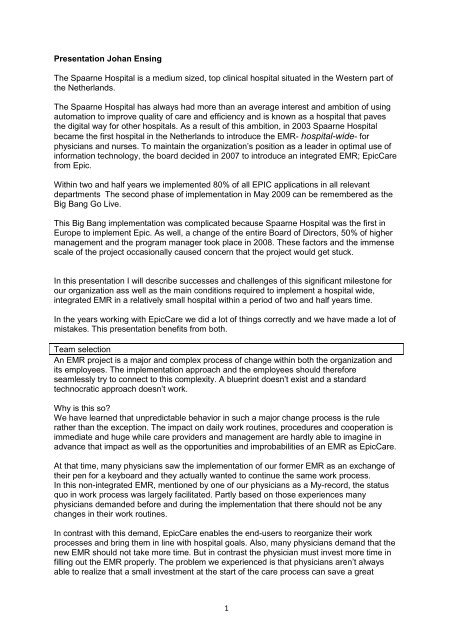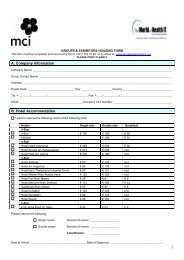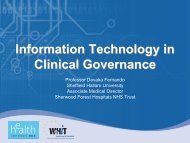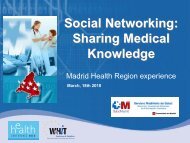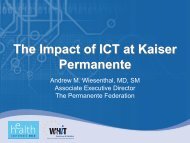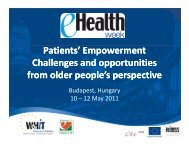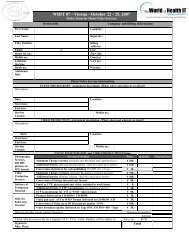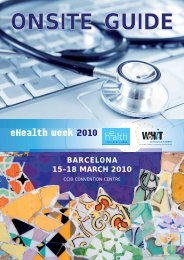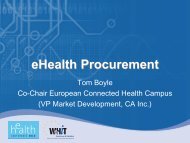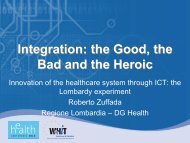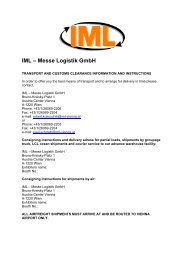1 Presentation Johan Ensing The Spaarne ... - World of Health IT
1 Presentation Johan Ensing The Spaarne ... - World of Health IT
1 Presentation Johan Ensing The Spaarne ... - World of Health IT
Create successful ePaper yourself
Turn your PDF publications into a flip-book with our unique Google optimized e-Paper software.
<strong>Presentation</strong> <strong>Johan</strong> <strong>Ensing</strong><br />
<strong>The</strong> <strong>Spaarne</strong> Hospital is a medium sized, top clinical hospital situated in the Western part <strong>of</strong><br />
the Netherlands.<br />
<strong>The</strong> <strong>Spaarne</strong> Hospital has always had more than an average interest and ambition <strong>of</strong> using<br />
automation to improve quality <strong>of</strong> care and efficiency and is known as a hospital that paves<br />
the digital way for other hospitals. As a result <strong>of</strong> this ambition, in 2003 <strong>Spaarne</strong> Hospital<br />
became the first hospital in the Netherlands to introduce the EMR- hospital-wide- for<br />
physicians and nurses. To maintain the organization’s position as a leader in optimal use <strong>of</strong><br />
information technology, the board decided in 2007 to introduce an integrated EMR; EpicCare<br />
from Epic.<br />
Within two and half years we implemented 80% <strong>of</strong> all EPIC applications in all relevant<br />
departments <strong>The</strong> second phase <strong>of</strong> implementation in May 2009 can be remembered as the<br />
Big Bang Go Live.<br />
This Big Bang implementation was complicated because <strong>Spaarne</strong> Hospital was the first in<br />
Europe to implement Epic. As well, a change <strong>of</strong> the entire Board <strong>of</strong> Directors, 50% <strong>of</strong> higher<br />
management and the program manager took place in 2008. <strong>The</strong>se factors and the immense<br />
scale <strong>of</strong> the project occasionally caused concern that the project would get stuck.<br />
In this presentation I will describe successes and challenges <strong>of</strong> this significant milestone for<br />
our organization ass well as the main conditions required to implement a hospital wide,<br />
integrated EMR in a relatively small hospital within a period <strong>of</strong> two and half years time.<br />
In the years working with EpicCare we did a lot <strong>of</strong> things correctly and we have made a lot <strong>of</strong><br />
mistakes. This presentation benefits from both.<br />
Team selection<br />
An EMR project is a major and complex process <strong>of</strong> change within both the organization and<br />
its employees. <strong>The</strong> implementation approach and the employees should therefore<br />
seamlessly try to connect to this complexity. A blueprint doesn’t exist and a standard<br />
technocratic approach doesn’t work.<br />
Why is this so<br />
We have learned that unpredictable behavior in such a major change process is the rule<br />
rather than the exception. <strong>The</strong> impact on daily work routines, procedures and cooperation is<br />
immediate and huge while care providers and management are hardly able to imagine in<br />
advance that impact as well as the opportunities and improbabilities <strong>of</strong> an EMR as EpicCare.<br />
At that time, many physicians saw the implementation <strong>of</strong> our former EMR as an exchange <strong>of</strong><br />
their pen for a keyboard and they actually wanted to continue the same work process.<br />
In this non-integrated EMR, mentioned by one <strong>of</strong> our physicians as a My-record, the status<br />
quo in work process was largely facilitated. Partly based on those experiences many<br />
physicians demanded before and during the implementation that there should not be any<br />
changes in their work routines.<br />
In contrast with this demand, EpicCare enables the end-users to reorganize their work<br />
processes and bring them in line with hospital goals. Also, many physicians demand that the<br />
new EMR should not take more time. But in contrast the physician must invest more time in<br />
filling out the EMR properly. <strong>The</strong> problem we experienced is that physicians aren’t always<br />
able to realize that a small investment at the start <strong>of</strong> the care process can save a great<br />
1
amount <strong>of</strong> time for themselves and other care providers further on in the chain <strong>of</strong> patient<br />
care.<br />
<strong>The</strong>se advantages arise from the integrated nature and chain orientation <strong>of</strong> the Epic system;<br />
this is the main strength <strong>of</strong> a We-record. In addition, task reallocation provides opportunities<br />
to decrease the workload for physicians.<br />
Altogether these variations <strong>of</strong> requirements mean that simple solutions aren’t sufficient;<br />
people and behavior are key, meaning that management and implementation should not be<br />
bureaucratic and distant.<br />
Strong involvement and flexibility serve as the basis. Learning is essential for both the user<br />
and the project team. This places high demands on the employees in the projectteam.<br />
After signing the contract with Epic, one <strong>of</strong> the first steps was the formation <strong>of</strong> the project<br />
team. Based on competence pr<strong>of</strong>iles, the former Board <strong>of</strong> Directors chose the best<br />
employees from the hospital to support the Epic project, including highly skilled and<br />
experienced department managers and experts on work processes in the OR, the ER,<br />
nursing departments etc. You will understand that this didn’t lead to applause from the<br />
remaining line management and employees.<br />
To prepare the projectteam as much as possible for their roles in this project, each team<br />
member was intensively trained on Epic applications and the Epic administer toolkit. This<br />
training was mainly followed in the US. <strong>The</strong> former department managers were also trained<br />
in project management and they had to take on the role <strong>of</strong> project manager.<br />
What are the success factors and lessons learned for <strong>Spaarne</strong> Hospital<br />
Trust is crucial for the success <strong>of</strong> the project. <strong>The</strong> projectteam should consist <strong>of</strong><br />
employees who have the knowledge <strong>of</strong> the organization, work and care processes, speak<br />
the language <strong>of</strong> the physicians and other care providers and are used to dealing with<br />
resistance. Make sure the project team works together at a central location to exchange<br />
knowledge and information and to give mutual support.<br />
Make sure the project members can take the point <strong>of</strong> view <strong>of</strong> the end-user so that they<br />
can understand what drives them and how they can find their WIIFM, sometimes solving<br />
minor issues for the end user will help them to attain their objective.<br />
Invest in the education <strong>of</strong> the projectteam concerning the EMR, project management,<br />
change management and process management.<br />
Big Bang Go Live<br />
<strong>Spaarne</strong> Hospital has chosen to implement 80% <strong>of</strong> the EMR in three short successive<br />
stages.<br />
Which considerations have played a part in this strategy<br />
A well-known phenomenon in change management is the reality <strong>of</strong> resistance. Resistance<br />
comes from the fact that people can and will change but they don’t want to be changed.<br />
<strong>The</strong> resistance that arises fluctuates in the various stages as they occur, such as<br />
bereavement as once described by Dr. Elisabeth Kübler-Ross.<br />
Imposed changes and giving up familiar working routine creates the feeling <strong>of</strong> losing control.<br />
<strong>The</strong> greater the autonomy, the stronger the emotions in the different stages can be<br />
experienced.<br />
To illustrate a short story in a number <strong>of</strong> statements from our physicians:<br />
Denial What’s the first thing they do <strong>The</strong>y think the new EMR will disappear!<br />
2
‘No seriously, this system will not last for 3 months!’<br />
Anger When I have a flat tire Epic is to blame! One <strong>of</strong> our physicians actually experienced<br />
this… this was a challenge for the helpdesk<br />
Bargaining Realizing you have to work with the system. You must reduce production otherwise I<br />
really can’t work with it.<br />
Depression Oh my God, what should I do I’ll quit and work somewhere else where they’re working<br />
with paper files.<br />
Acceptance Ok. It stays. Actually it’s a fine system. No, are you crazy, I wouldn’t go back to the old<br />
EMR.<br />
A common problem is that people get stuck in one phase. Thus a person may become stuck<br />
in anger, never moving on from the position <strong>of</strong> not accepting the inevitable future.<br />
When we just zoom in on the chart <strong>of</strong> Maxwell, we see in front a small group <strong>of</strong> innovators, a<br />
large middle group and at the back a small group <strong>of</strong> so called laggards, these employees will<br />
find themselves on the right behind and that’s where they will stay no matter what. Stop<br />
putting your energy into these employees but put your effort into the larger middle group<br />
where the potential to move to the forefront is most possible.<br />
A Big Bang should not only prevent a decline in the ‘mourning period’ within each new<br />
implementation, which can result in change fatigue; but it should also lead to quick and wide<br />
spread advantages <strong>of</strong> an integrated EMR such as digital ordering, using order sets, direct<br />
24/7 availability <strong>of</strong> all documented information throughout the whole chain <strong>of</strong> patient care,<br />
decision support, immediate availability <strong>of</strong> results etc.<br />
Another aspect, in which this decision played a role, was the strategy to make it impossible<br />
or as unattractive as possible to return to the old system or paperwork and to prevent<br />
working in several parallel systems.<br />
Finally we wanted to decline the frequency for training for more than 1,500 employees. We<br />
know from experience how difficult it is to get 1,500 employees out <strong>of</strong> their daily work for<br />
training activities.<br />
What are the conditions for a Big Bang GoLlive to be successful<br />
<br />
<br />
<br />
<br />
<br />
<br />
<br />
<br />
<br />
<br />
Formulate a clear vision <strong>of</strong> how the EMR will contribute to achieving the hospital goals.<br />
Get a good fit analysis<br />
Get an adequate framework for all implementation roles.<br />
Make clear in advance for the EMR to take time in one segment in order to save time at<br />
another location in the chain <strong>of</strong> operations. Also look actively for opportunities for task<br />
reallocation to reduce time spent for physicians<br />
Make clear in advance that work processes should and will change. Improvement has to<br />
be in line with hospital objectives.<br />
Use a sample configuration <strong>of</strong> the supplier.<br />
Get a proven implementation method so that the focus can be on unpredictable issues<br />
and not wasting time and energy on subjects that should be routine matters.<br />
Keep a good overview <strong>of</strong> the risks by applying a Go Live readiness assessment.<br />
Keep in mind that during ‘the renovation, sales continue.’ Adjust your support to this.<br />
Communicate loud and clear that optimal organizing <strong>of</strong> an EMR is impossible without<br />
actual experience. Learning and optimization is a continuous process that starts after the<br />
implementation and needs a special effort from all end users and project team members.<br />
Contribution <strong>of</strong> the board<br />
3
At the launch <strong>of</strong> the EMR project in 2008 many physicians lacked a sense <strong>of</strong> urgency. <strong>The</strong>y<br />
had access to a digital file, which was perfectly adapted to the details and needs <strong>of</strong> the<br />
individual physician.<br />
<strong>The</strong>re were also too few doctors who were able to look ahead and take their expectations<br />
from their individual perspective (the Me file) and exchange this for the over-all objectives <strong>of</strong><br />
the <strong>Spaarne</strong> Hospital. In this perspective, the patient is seen as the owner <strong>of</strong> the file and the<br />
physician is seen as a temporary administrator serving in the interest <strong>of</strong> the patient (the WE<br />
file).<br />
When there is no urgency, the leading role at the top <strong>of</strong> the hospital administration becomes<br />
more important.<br />
What is effective And what roles has the director completed in the <strong>Spaarne</strong> hospital<br />
As a leader the director sets the vision and goals; and puts the focus on the story on the<br />
future on how care will change and not on the clicks.<br />
As a figure head/sponsor the director inspires and motivates employees by expressing great<br />
personal commitment.<br />
As chairman <strong>of</strong> the program-board, the director made sure the lines <strong>of</strong> decision-making were<br />
short and transparent.<br />
In these roles there are some special topics regarding the group <strong>of</strong> physicians:<br />
Make sure the unpredictable behavior <strong>of</strong> the laggards is limited as much as possible by<br />
keeping a very close eye on them and, as a director, sometimes literally sitting next to them<br />
during their consultation hours.<br />
Let the director act as a lightning conductor when the pressure reaches high level so that the<br />
project team isn’t affected.<br />
Be personally present at difficult moments like for example the weekend and early morning<br />
as the team prepares for Go Live and be present during the Go Live phase on the<br />
department floor.<br />
Pay personal attention to key figures and put your ear to the ground.<br />
Walking on eggs shells can’t prevent conflicts with physicians. Only the director has the<br />
position to manage these conflicts effectively. Take full advantage <strong>of</strong> it!<br />
Finally I want to share some General tips with you:<br />
Ownership:<br />
Take care <strong>of</strong> management involvement, and by management I mean the medical-and<br />
division managers, and let them experience ownership. <strong>The</strong>y’re the ones to take the initiative<br />
for process redesign with the aid <strong>of</strong> EMR functionality. <strong>The</strong> projectteam has to work side by<br />
side with management and needs to inspire them by showing how existing and new<br />
functionality can solve their problems from today and tomorrow.<br />
Learning Strategy:<br />
Formulate a learning strategy with the credo: without effort no results!<br />
Make training and testing mandatory! Not competent = No access to the EMR!<br />
Optimization:<br />
Epic is a great EMR; to use it to its full potential you need to invest and spend much time for<br />
optimization. As mentioned earlier, the learning process starts after implementation and<br />
4
optimization starts with the learning process. Be prepared to put the same amount <strong>of</strong> time,<br />
energy and money in the optimization as in the implementation!! Optimization will bring you<br />
success.<br />
Communication:<br />
Don’t over promise and don’t under deliver! Communicate in different ways and don’t be<br />
disappointed when the message doesn’t come through. Use the doctors to make the doctors<br />
like it.<br />
5


